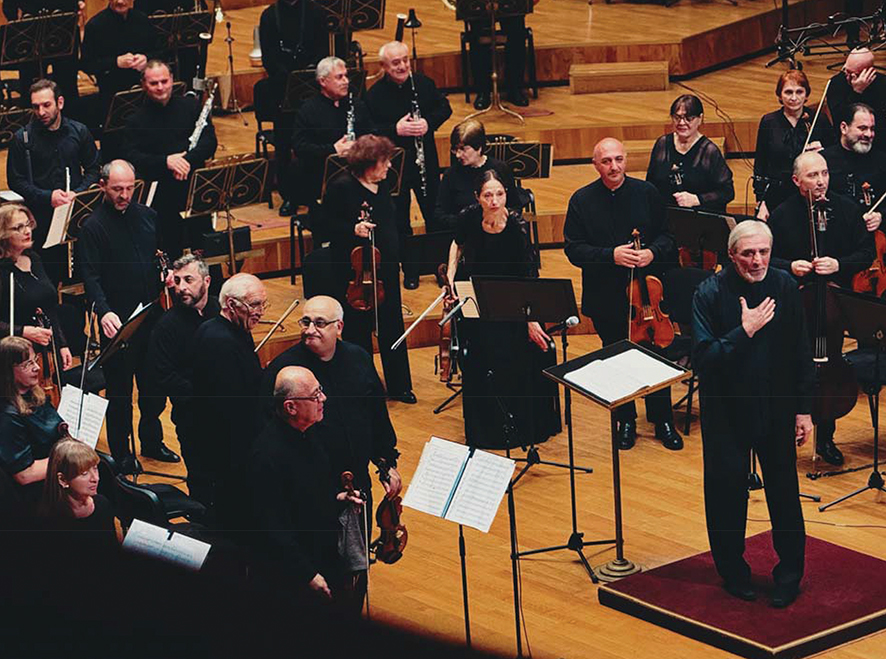In Tbilisi this October, two evenings were devoted to Sulkhan Tsintsadze — a composer whose legacy remains inseparable from Georgia’s twentieth century itself. The centenary celebrations, held on October 10 and 11, unfolded as encounters with a sound-world that once carried the aspirations, contradictions, and self-images of an entire culture. The first, presented by the Georgian State String Quartet and pianist Tamar Licheli at the Georgian Philharmonic Auditorium, concentrated on Tsintsadze’s chamber language; the second, led by Vakhtang Kakhidze with the Tbilisi Symphony Orchestra and the Georgian State Choir, illuminated his symphonic and cinematic imagination. Together, they offered a renewed confrontation with the musical DNA of Georgia’s modernity.
Tsintsadze’s centenary matters because his music remains one of the few cohesive attempts to articulate a national idiom without reducing it to folklore. Born in 1925, educated in Tbilisi and Moscow, he belonged to the generation that sought to reconcile Georgian intonation and Soviet modernism — an impossible synthesis that, paradoxically, produced some of the most lasting musical architectures of the period. His six string quartets, written between 1950 and 1976, mark a continuous dialogue between tradition and structure, ornament and line. The Sixth Quartet, performed at the first concert, is emblematic: it moves between modal lyricism and rhythmic volatility, between folk contour and chromatic saturation, but its form is always taut, architectural, unafraid of silence.
Hearing the Sulkhan Tsintsadze Georgian State String Quartet perform this music — Giorgi Khaindrava and Nika Barateli on violins, Nodar Jvania on viola, Giorgi Jorjadze on cello — was like watching a collective memory being reactivated through touch. The group, long synonymous with Tsintsadze’s name, has cultivated not just fidelity but a kind of physical empathy with his idiom. Their tone, matte and slightly raw, evokes the Caucasian polyphonic vocality that underlies much of Tsintsadze’s thinking.
The Miniatures for String Quartet, performed next, appeared almost as distilled commentaries on that larger language — small essays in timbre and rhythm, each a vignette of Georgian life refracted through Western form. Each miniature holds a micro-drama: a folk melody transformed by chromatic fog, a dance halted mid-turn, a fragment of speech turned into motif. The quartet performed them without sentiment, allowing the modernist edge — the intervals sharpened, the texture stripped to essentials — to speak clearly.
When pianist Tamar Licheli joined for César Franck’s Piano Quintet, the evening shifted from introspection to symphonic breadth. The Franck, of course, is a different world: its chromaticism is confessional, its emotional register European rather than Caucasian. Yet the juxtaposition was deliberate. It revealed how Tsintsadze’s music, for all its rootedness, belongs to the same emotional architecture — late-Romantic tension reimagined through a peripheral consciousness. Licheli’s phrasing was architectural, her dynamic control sculptural. The Georgian String Quartet responded with dark resonance, as if Franck’s harmonic storms were passing through another climate.
The following evening at the Djansug Kakhidze Center presented Tsintsadze’s orchestral persona — extroverted and cinematic. Vakhtang Kakhidze, conducting the Tbilisi Symphony Orchestra and Georgian State Choir, offered two large suites: from the ballet Rivares and from Tsintsadze’s film music, including the beloved Maya from Tskneti and Soldier’s Father.
The suite from Rivares revealed Tsintsadze’s orchestral clarity — his ability to create texture through density rather than volume. The strings shimmered in close voicings, while the winds articulated folk-like calls without imitating them. The rhythmic precision of the orchestra gave the music a sculptural presence: the dance episodes, built on irregular meters, felt less festive than ritualistic. Kakhidze’s conducting emphasized architecture over sentiment; he shaped climaxes like slow geological eruptions rather than bursts of color.

Tsintsadze’s film suites, presented in the second half, illuminated another facet of his voice — his ability to transform narrative music into moral commentary. The scores for Dragonfly, Bashi-Achuk, and Otar’s Widow remain among the most recognizable in Georgian cinema, yet when heard together, they form a kind of collective memory of the Soviet 1960s. In Otar’s Widow, the muted brass and restrained choral writing evoke both intimacy and desolation — the sound of a society that sings inwardly. Bashi-Achuk, with its rhythmic ostinati and modal drive, channels the mythic energy of folk epic into orchestral discipline. And Maya from Tskneti, the most famous, balances irony and warmth: its melody, almost naive in contour, becomes in orchestral form a study in repetition as nostalgia.
The Georgian State Choir, prepared by Archil Ushveridze, contributed an essential dimension — the human timbre that Tsintsadze always sought in his instrumental textures. Their blend was earthy, not ethereal, grounding the orchestral brilliance in a collective vocal body.
To hear these two concerts in succession was to move through the cultural psychology of Georgia itself. Tsintsadze’s language emerged during a time when modernism had to disguise itself in national costume, when experimentation survived under the rhetoric of tradition. His music encodes that paradox — it is both modernist and populist, both structural and melodic. Yet what makes it endure is not ideological cleverness but a profound understanding of musical form as historical consciousness.
In the chamber works, that consciousness manifests as counterpoint: voices negotiating space, asserting individuality within constraint. In the orchestral works, it takes the form of montage — fragments of melody and rhythm juxtaposed like film scenes, producing emotional meaning through sequence rather than development. Tsintsadze’s training as a cellist is audible in both dimensions: he thinks in layers, in physical gestures, in the tactile friction of sound against silence.
To speak of Tsintsadze today is to confront the question of how music remembers. Post-Soviet Georgia has inherited not only his scores but the ideological frameworks that once contained them. In the current moment, when nationalism and cosmopolitanism again define cultural discourse, Tsintsadze’s example offers a subtler model: a nationalism of structure rather than slogan, a cosmopolitanism of form rather than style. His quartets and suites show how the local can achieve universality not through exoticism but through compositional logic.
Review by Ivan Nechaev














